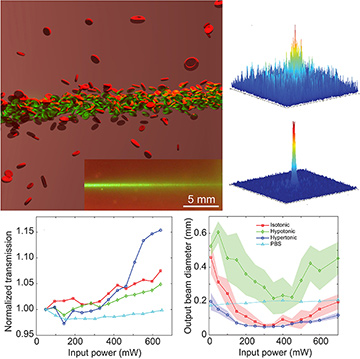 Left: Nonlinear trapping of a light beam, mediated by optical forces, can turn RBCs into a biological waveguide (see video). Inset shows a side-view image of a self-trapped beam. Center: Output intensity patterns show linear diffraction with strong scattering at low power (10 mW, upper plot) and nonlinear self-trapping of laser beam at high power (200 mW, lower plot), through hypertonic RBC suspension. Graphs: Normalized transmission (left) and output beam size (right) as a function of input power in RBC suspensions under three osmotic conditions, as well as in plain buffer solution (PBS) without RBCs. [Enlarge figure]
Left: Nonlinear trapping of a light beam, mediated by optical forces, can turn RBCs into a biological waveguide (see video). Inset shows a side-view image of a self-trapped beam. Center: Output intensity patterns show linear diffraction with strong scattering at low power (10 mW, upper plot) and nonlinear self-trapping of laser beam at high power (200 mW, lower plot), through hypertonic RBC suspension. Graphs: Normalized transmission (left) and output beam size (right) as a function of input power in RBC suspensions under three osmotic conditions, as well as in plain buffer solution (PBS) without RBCs. [Enlarge figure]
When light propagates through turbid media, it is often strongly scattered before achieving deep penetration and long-range transmission. This becomes an arduous hurdle in many biological applications, from imaging to biosensing, that rely heavily on information transfer through such media. Over the past decade, nonlinear optics has emerged as a powerful tool to achieve enhanced transmission of light in a variety of soft-matter environments,1,2 including dielectric,3 plasmonic and even biological suspensions.4–5
We recently demonstrated nonlinear-optical effects with human red blood cells (RBCs), suspended in different osmotic solutions, that enable self-trapping, scattering-resistant propagation of a laser beam through RBC suspensions. This nonlinear RBC response forms waveguides that enable deep penetration of light over several centimeters within the solution, and that minimize scattering loss.5
We have shown that a laser beam shining through RBC suspensions can become “self-trapped” within a narrow conduit, formed via optical forces that spatially rearrange the RBCs, allowing propagation without scattering loss. The work demonstrates, contrary to common belief, that self-focusing and self-trapping of light can be achieved via a nonlocal, nonlinear effect—the interplay of optical-gradient and forward-scattering forces.4,5
Furthermore, the osmotic condition of the blood (isotonic, hypotonic or hypertonic) significantly affects the optical forces at play within this light-guiding phenomenon; the different shapes and refractive indices of cells modify the optical-force-induced nonlinearity, such that the strength of the nonlinearity increases with the osmotic pressure on the cells. Our experiments revealed that the RBCs’ osmotic conditions could quantitatively modify the magnitude of the beam self-trapping, without significant photodamage for laser powers of a few hundred mW.
The ability to focus light through a strongly scattering medium, such as blood, may prove a significant step toward the creation of enhanced noninvasive imaging and sensing technologies in the visible or NIR regimes. This technology could also offer a diagnostic tool to identify modifications or defects in the morphological features of cells, found in pathologies such as sickle cell disease or malaria.
Researchers
R. Gautam, Y. Xiang, J. Lamstein, Y. Liang, A. Bezryadina, G. Liang, A. White, M. Silverman, S. Kazarian and Z. Chen, San Francisco State University, San Francisco, Calif., USA
J. Xu, Nankai University, Tianjin, China
R. Morandotti, Université du Québec, Québec, Canada
B. Wetzel, Université de Limoges, Limoges, France
T. Hansson, Linköping University, Linköping, Sweden.
D. Preece, University of California Irvine, Irvine, Calif., USA
References
1. O. Brzobohatý et al. ACS Photonics 6, 403 (2019).
2. G. Marcucci et al. arxiv.org/abs/1907.02823 (2019).
3. W. Man et al. Phys. Rev. Lett. 111, 218302 (2013).
4. A. Bezryadina et al. Phys. Rev. Lett. 119, 058101 (2017).
5. R. Gautam et al. Light Sci. Appl. 8, 31 (2019).

